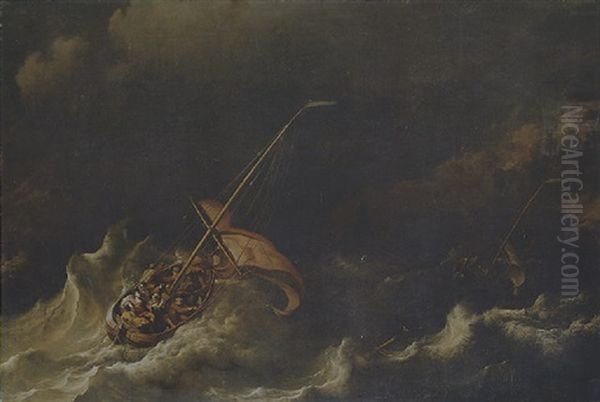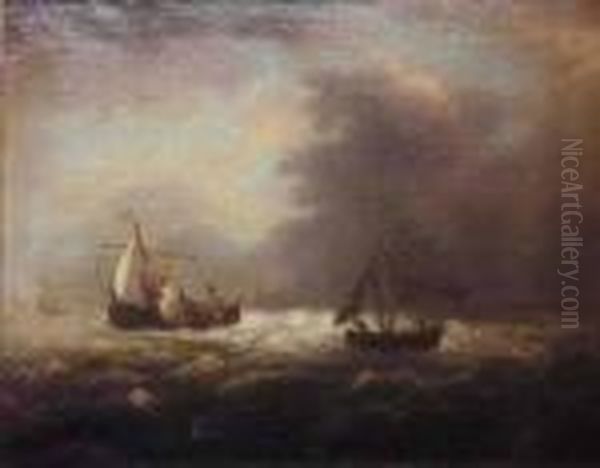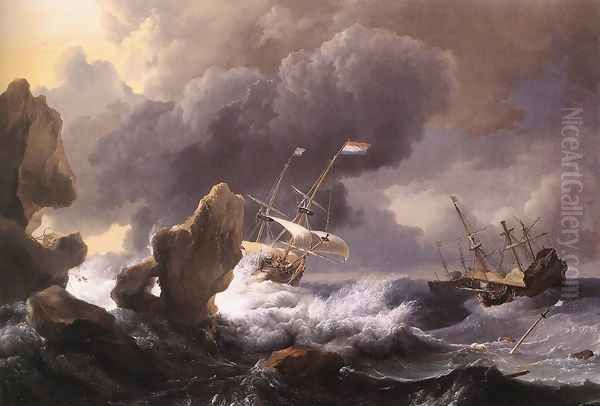
Ludolf Backhuysen stands as one of the most significant and dramatic painters of the Dutch Golden Age, renowned primarily for his powerful and evocative marine scenes. Active during a period when the Dutch Republic was a dominant maritime power, Backhuysen captured the energy, peril, and beauty of the sea with unparalleled skill and intensity. His work, ranging from tempestuous storms that tested the limits of ships and sailors to bustling harbour views celebrating Dutch commerce and naval might, cemented his reputation both in his own time and for posterity. Born in Germany but spending his productive life in Amsterdam, he became the leading marine painter in the Netherlands following the departure of the Van de Veldes to England.
From Emden to Amsterdam: Early Life and New Beginnings
Ludolf Backhuysen was born in Emden, East Frisia (now Germany), in 1631. Emden, a significant port city, likely provided the young Backhuysen with his first exposure to the maritime world that would later dominate his art. Around 1650, seeking opportunities in the thriving Dutch Republic, he relocated to Amsterdam. This city was not only the bustling heart of global trade and Dutch naval power but also a vibrant centre for the arts, offering fertile ground for an aspiring talent.
Initially, Backhuysen did not pursue art professionally. He found employment as a clerk and notably as a calligrapher ('pen-man') with the prominent merchant house of Bartolotti. His skill in calligraphy was reportedly exceptional, foreshadowing the meticulous detail and fine control that would later characterise his drawings and paintings. This early career provided him with financial stability and immersed him in the commercial atmosphere of Amsterdam, where the sea was an omnipresent factor in daily life and economic prosperity. The transition from scribe to painter seems to have occurred gradually during the 1650s.
The Call of the Sea: Artistic Training and Influences

Backhuysen's path to becoming a painter was somewhat unconventional for the era, likely involving significant self-teaching alongside formal instruction. Art historical sources confirm that he received training from at least two established Amsterdam artists: Allart van Everdingen and Hendrick Dubbels. Van Everdingen, known primarily for his Scandinavian-inspired landscapes featuring waterfalls and pine forests, also painted seascapes, and his dramatic compositions may have influenced Backhuysen. Hendrick Dubbels was a dedicated marine specialist, and his tutelage would have provided Backhuysen with direct grounding in the genre's conventions and techniques.
While not definitively documented as his direct teachers, the influence of Willem van de Velde the Elder (c. 1611-1693) and his son, Willem van de Velde the Younger (1633-1707), is undeniable. The Van de Veldes were the preeminent marine painters in the Netherlands until their departure for England in 1672. Backhuysen certainly studied their work closely, absorbing their mastery of ship portraiture, atmospheric effects, and compositional strategies. Some early accounts even suggest he initially learned by copying their works. His style, however, quickly developed its own distinct character, often favouring more dramatic and turbulent scenes compared to the often calmer, more detailed reportage of the younger Van de Velde. Another likely influence was Simon de Vlieger (c. 1601-1653), an earlier master of marine painting known for his subtle atmospheric effects and tonal harmonies, particularly in his use of grey palettes, which Backhuysen adapted.
Capturing the Tempest: Style and Subject Matter
Backhuysen is most celebrated for his dramatic depictions of ships navigating rough seas and violent storms. He possessed an extraordinary ability to convey the immense power of wind and water, capturing the churning waves, the spray kicked up by the wind, and the dramatic play of light breaking through storm clouds. His ships are not static objects but dynamic participants in a struggle against the elements, their sails straining, hulls pitching, and rigging rendered with impressive accuracy even amidst the chaos. This focus on the sublime power of nature became a hallmark of his work.
His dedication to realism was legendary. An often-repeated anecdote, likely embellished over time but indicative of his reputation, claims that Backhuysen would hire a boat and crew to take him out onto the turbulent waters of the Zuiderzee during storms, purely to observe the effects firsthand. Whether strictly true or not, his paintings demonstrate a profound understanding of maritime conditions, ship handling, and atmospheric phenomena, suggesting intense observation.

While famed for storms, Backhuysen's oeuvre also includes calmer scenes: bustling harbour views, ships lying at anchor in roadsteads, ceremonial ship parades, and depictions of specific naval battles. In these works, his meticulous attention to detail shines through, accurately rendering ship architecture, flags, and the activities of sailors and dockworkers. His palette, often dominated by cool greys, blues, and greens in his storm scenes, could shift to warmer tones and brighter light in calmer harbour views, demonstrating versatility. He masterfully employed chiaroscuro, using strong contrasts between light and shadow to heighten drama and focus attention.
Masterworks of the Marine Genre
Backhuysen's prolific output includes numerous paintings now held in major museums worldwide. Several stand out as particularly representative of his skill and thematic concerns:
Amsterdam Harbour on the IJ (1665, Musée du Louvre, Paris): This large-scale painting is a significant early masterpiece. It presents a panoramic view of Amsterdam's busy waterfront, filled with various vessels, including warships and merchant ships. The work celebrates the city's maritime prowess and commercial vitality. It was commissioned by the city magistrates of Amsterdam as a prestigious diplomatic gift for Hugues de Lionne, secretary of state to King Louis XIV of France, highlighting Backhuysen's growing reputation.
Christ in the Storm on Lake Galilee (c. 1695, various versions exist): Tackling a biblical theme allowed Backhuysen to combine his expertise in depicting tempests with profound religious narrative. These works show the disciples panicking as waves crash over their small boat, while Christ remains calm. The dramatic intensity and emotional turmoil are palpable, showcasing his ability to infuse marine scenes with deeper meaning. This subject had famously been treated by Rembrandt van Rijn earlier in the century, and Backhuysen offered his own powerful interpretation.
The Battle of Texel (painted after 1673): Backhuysen depicted several naval engagements from the Anglo-Dutch Wars. His paintings of the Battle of Texel (or Kijkduin), the final major battle of the Third Anglo-Dutch War, capture the chaos and grandeur of naval warfare. These works required complex compositions featuring numerous accurately rendered warships engaged in combat, demonstrating his skill in historical documentation as well as artistic interpretation.
Ships at Sea (various dates, e.g., 1660s, Private Collection): Many works with this general title exist, often showcasing Backhuysen's signature storm scenes. They typically feature one or more Dutch vessels battling high winds and towering waves under dramatic, cloud-filled skies, emphasizing the dangers and heroism associated with seafaring.
Ships in the Roadstead of Enkhuizen (Staatliches Museum, Schwerin): This work exemplifies his ability to portray calmer, yet still active, harbour scenes. It depicts ships anchored near the port of Enkhuizen, another important Zuiderzee town, showcasing different types of vessels and the daily life of the harbour with meticulous detail.

The States Yacht of Prince Maurice of Orange (Etching, c. 1660, Het Scheepvaartmuseum, Amsterdam): This early, unpublished etching demonstrates his skill in printmaking and his interest in depicting specific, important vessels. It highlights his versatility beyond oil painting.
These examples represent only a fraction of his extensive output but illustrate the range and depth of his contribution to marine art.
Beyond the Brush: Techniques and Versatility
Ludolf Backhuysen was a technically accomplished artist proficient in multiple media. His primary medium was oil painting, typically on canvas but sometimes on panel. His brushwork could vary from fine, detailed rendering, especially in the rigging and ornamentation of ships, to broader, more expressive strokes used to capture the movement of water and clouds. He often employed impasto – thick applications of paint, particularly white – to represent the foam and spray of breaking waves, adding texture and dynamism to the surface. Glazing techniques were likely used to achieve depth and luminosity in the water and sky.
Beyond oil painting, Backhuysen was a skilled draftsman. Numerous drawings survive, often executed in pen and ink with grey wash, serving as preparatory studies for paintings or as finished works in their own right. These drawings reveal his confident hand and keen observational skills.
His early training as a calligrapher perhaps contributed to his proficiency in etching. He produced a number of etchings, mostly focusing on marine subjects. While not as central to his fame as his paintings, these prints demonstrate his mastery of line and tone in a different medium and allowed his compositions to reach a wider audience. His versatility extended his influence and showcased the breadth of his artistic talents.
Navigating Success: Career and Patronage
Backhuysen's career gained significant momentum after he joined the Amsterdam Guild of Saint Luke in 1663, the official body for painters and other craftsmen. His reputation grew steadily, particularly after Willem van de Velde the Elder and Younger moved to England in 1672, leaving Backhuysen as the undisputed leading marine painter in the Dutch Republic. His workshop in Amsterdam became highly successful, attracting pupils and producing a large volume of work.
His fame extended beyond the Netherlands, attracting prestigious international patrons. Tsar Peter the Great of Russia visited Backhuysen's studio during his trip to Holland in 1697 and reportedly admired his work greatly, even taking drawing lessons from the master. Cosimo III de' Medici, Grand Duke of Tuscany, was another important client, commissioning works during his own visits to Amsterdam. Frederick I of Prussia and Augustus II the Strong, Elector of Saxony and King of Poland, were also among his admirers and patrons. The aforementioned commission from the city of Amsterdam for Louis XIV of France further attests to his high standing.
Later in his life, Backhuysen even operated a gallery or viewing room for art on the upper floor of the Amsterdam Town Hall (now the Royal Palace), a testament to his established position within the city's cultural life. This success allowed him considerable financial security and social standing.
A Sea of Talent: Contemporaries and the Artistic Scene
Ludolf Backhuysen worked during the absolute peak of the Dutch Golden Age of painting. Amsterdam was teeming with artistic talent across various genres. While Backhuysen specialized in marine art, he was contemporary with giants in other fields. Johannes Vermeer was creating his serene interior scenes in Delft, while Frans Hals was capturing the personalities of Haarlem's citizens in lively portraits. Rembrandt van Rijn, though belonging to a slightly older generation, was still active in Amsterdam during Backhuysen's early career. Landscape painters like Jacob van Ruisdael, sometimes incorporating coastal views, were also highly regarded.
Within the specific field of marine painting, Backhuysen's main predecessors and contemporaries included Jan Porcellis, an early innovator known for his tonal subtlety; Simon de Vlieger, whose atmospheric approach influenced many; the aforementioned Willem van de Veldes (Elder and Younger), masters of detailed ship portraiture and battle scenes; Jan van de Cappelle, celebrated for his luminous calm seascapes, offering a contrast to Backhuysen's drama; and Reinier Nooms, known as 'Zeeman', who specialized in detailed views of ships and Mediterranean ports. Abraham Storck, a slightly younger Amsterdam contemporary, worked in a style often indebted to Backhuysen, focusing on harbour scenes and river views. Backhuysen navigated this rich artistic environment, carving out his unique niche with his focus on dynamic and often dramatic interpretations of the sea.
Ripples Through Time: Influence and Legacy
Backhuysen's powerful style and technical prowess exerted considerable influence on subsequent generations of marine painters, both in the Netherlands and abroad. His dramatic compositions and focus on atmospheric effects resonated with later artists. Among his direct pupils or followers were Michiel Maddersteg, Jan Claesz. Rietschoof, and Aernout Smits. As mentioned, Abraham Storck also clearly absorbed elements of Backhuysen's style, particularly in his treatment of water and skies. Jan Theunisz Blanckerhoff was another contemporary marine painter whose work shows Backhuysen's influence during the 1660s.
His impact extended beyond his immediate circle. The popularity of his storm scenes contributed to the enduring appeal of the sublime in marine art. While direct lineage can be hard to trace definitively, the dramatic seascapes of 18th and 19th-century artists, including figures of the Romantic movement like J.M.W. Turner in Britain, arguably owe a debt to the tradition of dynamic marine painting significantly shaped by Backhuysen and the Van de Veldes. He helped establish the dramatic seascape as a major theme within European art. His works remain highly sought after by collectors and are staples in museum collections focusing on Dutch Golden Age art.
Final Voyage: Later Life, Family, and Death
Backhuysen remained active as an artist well into his old age, continuing to paint and draw until shortly before his death. His personal life included four marriages. Little is known about his first two wives. His third marriage, in 1660, was to Agatha van Howard, daughter of a silk merchant, which likely brought increased financial stability. After her death, he married Anna de Hooghe in 1680, who also predeceased him. Despite these personal losses, his artistic production continued.
Ludolf Backhuysen died in Amsterdam in November 1708, at the age of 77. He was buried in the city's Westerkerk, a prominent church where Rembrandt had also been laid to rest decades earlier. He left behind a significant body of work and a lasting reputation as one of the Netherlands' foremost painters of the sea.
Reappraising the Master: Art Historical Reception and Study
During his lifetime and in the decades immediately following his death, Ludolf Backhuysen enjoyed immense fame and critical acclaim. He was considered the leading marine painter of his time after the departure of the Van de Veldes. However, during the later 18th and much of the 19th centuries, as artistic tastes shifted, his reputation somewhat declined, overshadowed by the perceived greater subtlety of artists like Jan van de Cappelle or the detailed accuracy of Willem van de Velde the Younger. His work was sometimes criticized as overly dramatic or formulaic.
A significant reappraisal began in the late 20th century. Renewed scholarly interest and major exhibitions helped restore his standing. A key moment was the first large-scale monographic exhibition dedicated to Backhuysen, held jointly in Emden (his birthplace) and Amsterdam in 1985. This exhibition and its accompanying catalogue brought his achievements back into the spotlight.
The publication of Gerlinde de Beer's comprehensive monograph and catalogue raisonné, "Ludolf Backhuysen (1630-1708): Sein Leben und Werk" (Ludolf Backhuysen: His Life and Work) in 2002, provided a crucial scholarly foundation for all subsequent research. This work solidified his position as a major figure and remains the standard reference. Continued interest is evidenced by more recent exhibitions, such as another dedicated show in Emden in 2023, further exploring his work and context. Despite this renewed attention, some aspects of his life, particularly the precise details of his early artistic training before Everdingen and Dubbels, remain subjects of scholarly discussion. His versatility as a draftsman and etcher also continues to attract study.
Enduring Storms: Conclusion
Ludolf Backhuysen remains a towering figure in the history of marine painting. As a master chronicler of the Dutch relationship with the sea, he captured both its vital importance to the Republic's prosperity and its terrifying, untamable power. His dramatic storm scenes are iconic, showcasing technical virtuosity in depicting turbulent water, wind-filled sails, and atmospheric turmoil. Yet, his oeuvre also reveals a capacity for detailed observation in calmer harbour views and historical naval scenes. Working alongside and succeeding the famed Van de Veldes, he carved his own distinct path, influencing generations of artists who followed. Through his powerful brushstrokes, Backhuysen immortalized the dynamic spirit of the Dutch Golden Age and its profound connection to the maritime world, leaving a legacy as enduring as the storms he so masterfully depicted.